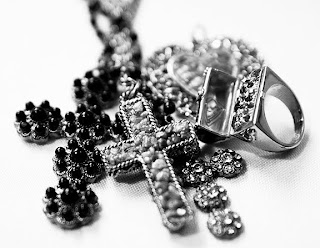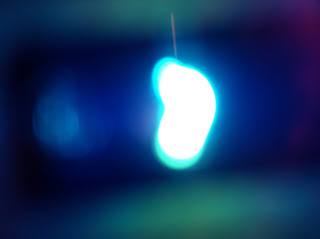Tuesday, March 29, 2011
Task 5 - Matin Pezeshgzad
Abstract colour in photography...
Color is never within an object itself. Color is in the light reflected onto it and is ultimately what we perceive as colour.
Assignment 1 Task 4
Jewelry without colour seems a bit obsolete. Growing up as a girl you often observe the jewelry your mom wears or stores away in her dresser. I think we are more fascinated with the colour of the jewels than the value of the jewelry itself. The value of the gems are based on colour as well. Turning my image black and white takes the 'sparkle' away. The jewelry doesn't seem as precious or worth investigating though instead of being distracted by the type of precious metals or gems, we are instead engaged by the symbolism of the jewelry. The image appears more modest than it would be with colour. The image would be about value and beauty rather than the religious symbol it is in black and white.
Reese's Task Number Five
This series was inspired by Carly's presentation on "feminist roles and colour". I used pieces from the board game Men are from Mars, Women are from Venus, which was based on the book with the same title written by Dr. John Gray. Gray's overall message was that men and women have such different expectations, needs and attitudes that they may as well have been from different planets. By isolating certain objects of the game and placing them beside each other, I hope to punctuate or bring attention to the stereotypical aspect of gender roles in contemporary North American society apparent in this game. In terms of its used of colour, for example, men are assigned the colour red that is commonly associated with strength, power, aggression and excitement. Women are assigned the colour teal, which is thought to have a feminine appeal and sometimes used to symbolize sophistication.
Monday, March 28, 2011
ASSIGNMENT #1, Task #5 by Caitlin Baker
This series is inspired by Caitlin Cox's presentation on the use of color as link for a series of photographs that are otherwise dissimilar. Robyn has also shown many artists whose sequences are built upon different that images that play off each other, as opposed to many versions of the same photograph.
This is a concept that I have been drawn to for some time, and found myself writing down nearly all of the artists Caitlin presented as references. My thesis work has also gone down this path.
This series is an attempt to create a narrative using photographs that were taken at different times, places, and have different content. I am using a neutral color palette as a device for continuity.
Task 5: Stefanie Cocuzzo
The following task was interpreted by the presentation given "Colour Palette and its affects on the viewer". Looking more closely to the artist Rinko Kawauchi in her series where blue is the prominent colour. Her subjects include family, human interaction with nature and the cycle of life photographed using this pastel palette. What was also appealing was her use of different subject matter to create a series of images. The images represent a state of conscious, self relation to body, nature and object.
Light blue is associated with health, healing, tranquility, understanding, and softness. blue is linked to consciousness and intellect.
Dark blue represents knowledge, power, integrity, and seriousness.
Lady Gaga performing Paparazzi - Renée Drexler (task 5)
My inspiration for this exploration is inspired by Katie Stewart’s presentation on Abstract photography. It seems that all the experimentation in this era of photography uses analog processes. I wanted to see if I could develop a process using digital photography. For the first time in the history of photography, digital technology has allowed for a relentless exchange of images. We all take part in this exchange on some level. Some of us have even become a paparazzi in our own right by obsessively documenting our lives and posting our experiences virtually. This thought instantly brought Lady Gaga to mind. I decided to take pictures of Gaga’s video “Paparazzi” in an attempt to comment or ask whether it makes a difference if I take a picture of her on a screen or in person. It seems impossible to dissect the real person from the Gaga performance. She cannot escape her iconic status, and any moment of her life can become a spectacle. By revisiting the video and documenting it like a paparazzi photographer, I attempt so slow things down by using a slower shutter speed to create blurry and soft imagery which contrast Gaga’s aesthetic. By capturing various frames within one frame, Gaga’s ghostly figure is swallowed up and disappears within a form that represents the aperture of a camera.
task five: kevin chaves
RED: increases physical energy, vitality, stamina,
grounding, spontaneity, stability, passion
BLUE-INDIGO: increases calmness, peace, love, honesty, peace,
kindness, truth, inner peace, emotional depth, devotion
GREEN: supports balance, harmony, love,
communication, social, nature, acceptance
COLOUR, the simple solution to all of life's problems
Caitlin Cox: Task 5
I was intrigued by the artist Yayoi Kusama and her fascination and obsession with dots. I found it interesting that she uses dots in her work as a form of self therapy. I wanted to make a photograph that suggested a repetitive gesture. The action and repetitive motion of drawing short lines on a notepad can be meditative.
I found this assignment to be quite difficult. I'm not sure if it was because of the nature of the assignment, or if I just got stuck this week. As a result, I am not too happy with my execution of this assignment because I don't think the message comes across clearly. The image is also relatively colourless, where Kusama's work is usually very bright and exciting.
Tattoo Embroidery (task 4) Renée Drexler
When I look at a black and white photograph, I view it in relation to the history of photography. I have never really enjoyed modernist work by Ansel Adams, or the black and white photograms by Man Ray, nor the images of Edward Weston. I can appreciate these images in the context of the history of the medium, but the images themselves have never instill much feeling while I look at them. I do however really enjoy looking at carte de visites and images of women cross dressing as men from the 19th century. I think I enjoy the carte de visites because it was the beginning of photographs emergence into a more mainstream commodity. As for the images of women wearing pants, this alludes to the revolutionary spirit instilled in dress reformers which eventually lead to the Suffragette movement. My thesis work this year, attempts to subvert the objectification of the female nude throughout art history.
In the west, embroidery is a traditional female practice. I decided to apply this pattern onto the skin of the female subject. This image attempts to reflect upon how women where labeled as being domestic, serene, docile and loving mothers, etc. More so, within the frame, the female was usually used as a prop, an object staring into space for the viewer to appreciate. There were not very many opportunities to move away from these stereotypes. Stereotypes and social codes of behaviour are often invisible tattoos that we all wear. The oval frame alludes to the historical time I am referencing in this work.
Task Five: Katie Stewart
IMITATE
Obsessional
Abstract, Experimental, Alternative
photographic process
of
Objects, Colour, Light.
A sightless composition created
from
Shapes, Textures, Repetition.
Saturday, March 26, 2011
Assignment 1, task 5 - Elena Franzese
In relation to the presentation done on colour therapy, where the chakras were discussed, I chose to do a self portrait illustrating one of the chakras as being more dominant than the other 6. Mentally, Ajna deals with visual consciousness. The Ajna, a.k.a. Brow, a.k.a. Third Eye chakra is the one shown here, being represented by the colour violet, which is the colour to signify it by.
Thursday, March 24, 2011
Reese's Task Number Four
Using methods common to explorations in typology, such as adherence to particular compositions and similar applications of artificial and available light, I have photographed close to thirty portraits of socks in their usual ball state when I am not using them. Socks, like many other types of clothing, are often adorned with rich use of colour and design to appeal to varying tastes and preferences. Each pair is a set of containers that can conform to the unique body shapes of its user, similar to the way film and digital media depend on the particular mechanical settings and local conditions in which the photographs are made. Sock balls, however, is a pair that has been turned inside out, stretched and twisted, becoming containers contained within them, all as if devouring each other. The precision of colour and design are temporarily disabled but its structural make-up must still contort and adapt in its attempt to negotiate with the changing needs and demands of its owner. While studying in OCAD, I have often come across people who speak of their black and white imagery with an heir of superiority, as though colour is unrefined or superfluous. As expected, they have usually been matched with arguments supporting otherwise. While "After Colour" engages with particular use and thoughts surrounding greyscale applications, it is also accompanied by investigations and perhaps some doubt in the role and meaning of colour in a world that cannot escape it and with which we have become so familiarized.
4 - Matin Pezeshgzad
Wednesday, March 23, 2011
Filena Arcia Task #4
 | ||
| Rothko White Center (Yellow, Pink & Lavender on Rose) 1950 |
 |
| Rothko Violet, Green and Red 1951 |
 | ||
| Rothko Number 8 1952 |
When I first viewed the images from the “After Colour” exhibition the images and the title itself made me think of movements that were strongly based in colour such as the Colour Field Movement. The movement was characterized mostly by large fields of solid flat colour spread or stained onto a canvas and the emphasis was not about gesture or brushstrokes or action but more about overall consistency of form and process. I began to think about how images from this time would look if all the colour was taken out of them. How would it change the affect on the viewer? I decided to choose some painting created by Rothko to experiment on. I choose Rothko so several reasons. He was known as one of the main painters of that movement but yet he rejected being attached to it and he also had an interesting relationship with colour or how colour should function. In a quote by him you can see how some of the colour field ideas conflicted with his own:
I am not an abstractionist ... I am not interested in the relationship of color or form or anything else. ... I'm interested only in expressing basic human emotions — tragedy, ecstasy, doom and so on — and the fact that a lot of people break down and cry when confronted with my pictures show that I communicate those basic human emotions. ... The people who weep before my pictures are having the same religious experience I had when I painted them. And if you, as you say, are moved only by their color relationships, then you miss the point!
It is interesting to note that while he doesn’t want us to be moved or focus only on the colour relationship some of his titles for the most part point out this colour relationship. I chose a couple of his paintings and change the colours to black and white in photoshop and I then used the sliders to create more of an emphasis on texture and the “hand of the artist” which goes against the movement. I did this to see how it would change the reading of the image. I also did it because I found that removing the colour helped the viewer to not be distracted by it and possibly see what Rothko was trying to get people to see. Human emotion created not by colour relationships. With out the colour does the painting still have the same impact? I believe that without the colour they do still have a sense of tragedy and doom and maybe even more so however I do think that our society is very rooted in colour as a method of generating emotion especially when we think of colour therapy and because of this we may not know what emotional response to have with the painting at first and may need to spend more time with each one to differentiate the different emotions we feel.
Tuesday, March 22, 2011
Task #4 Bailey Wilson
After Colour sparked the thought After Life for me, and I decided to create this work based on the remains of an animal. The bones and fur are identifiable and yet still look abstract to me somehow.
The animal, whose bones these belonged to, no longer exists as a living thing, the colour has gone from its body to keep the colour and life going for another animal, the one who consumed it.
task four: Kevin Chaves
This past weekend I went back home to visit my family. My parents are redecorating our house, which includes painting several walls. I went with my mom to look at colour swatches. This led me to start thinking abut colour in reference to class and the 'after colour' task. I took several swatches home. I scanned them and using the eyedropper I selected each colour. I then removed the colour from the images. What was left was obviously just different shades of gray. I renamed each shade with the name that was found on each swatch. The removal of colour completely changes the meaning of these swatch cards.
cloudless 510B-4
cool melon 170B-4
cucumber crush 440C-2
empress trail 510B-7
old vine 440F-6
red tomato 170B-7
sandwashed driftwood 770D-6
strawberry mousse 170A-2
Monday, March 21, 2011
TASK 4: Stefanie Cocuzzo
The following diptych represents an area of exploration that i have been interested in for awhile. The ideas of the abandoned space and what is left behind is something that i wanted to represented with these images. Evoking a sense of time and wonder about the space and those who've once inhabited the space. The remains of the structure of the house and representations of breaking down materials allows us to question why are these buildings still present; this house in articular is located on a side road tucked away from flowing traffic it's loneliness is revealed by its current state of abandonment.
Caitlin Cox: Task 4
Black and white photographs capture the feeling of nostalgia, possibly an incomplete memory. I recently went on a weekend trip to visit an old friend in Montreal. The visit is now just a memory, but these visual, tangible moments will keep me from forgetting entirely.
Subscribe to:
Comments (Atom)














































